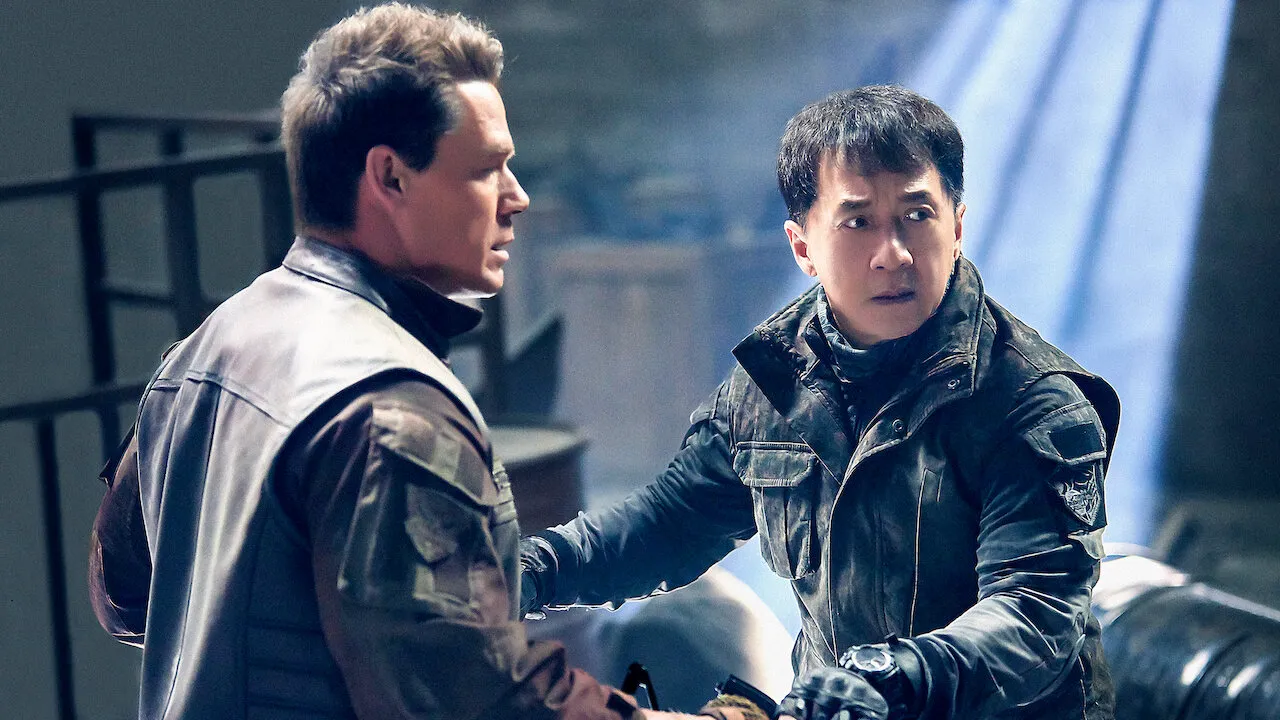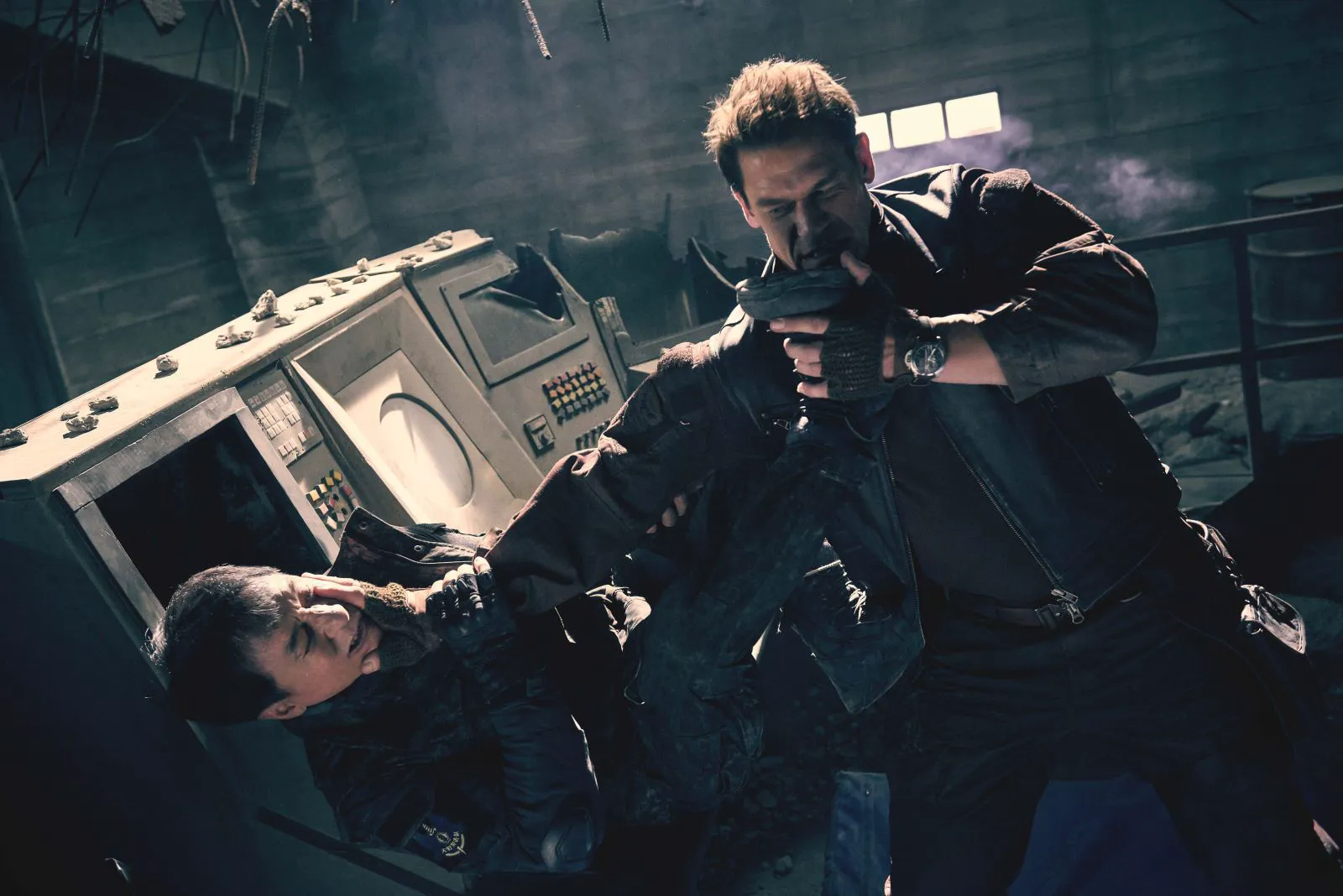A group of mercenaries attacks an oil production complex owned by the Chinese corporation Unicorp. Former special agent Luo Feng (Jackie Chan) and his team try to rescue the workers and evacuate them from Iraq via the so-called “Highway of Death.” The situation is complicated by the fact that his own daughter, Luo Mei (Ma Chunrui), with whom he lost contact long ago, is among the complex’s employees.
Among the mercenaries is another former soldier, Chris Van Horne (John Cena). He doesn’t know the details of his mission and thinks he’s fighting terrorists. When Van Horne realizes what’s going on, he decides to help Luo Feng. Now, the two of them must confront a large mercenary army to prevent the villains from seizing the oil reserves.

Jackie Chan as Luo Feng in a still from “Hidden Strike”
“Hidden Strike”: A Reflection of Modern Blockbuster Trends
“Hidden Strike” is a curious reflection of the modern blockbuster industry, a cinematic symbol of how far Chinese cinema has come in recent years. Since the days of Bruce Lee, Asian action stars have occasionally appeared in Hollywood films, but more often as villains, in supporting roles, or, at best, paired with a talkative American. Their characters were often the butt of jokes, and their fighting abilities were cleverly concealed by rapid Hollywood editing—to varying degrees (“Rush Hour 2”).
By 2023, the scales have tipped in the other direction. Now, Chinese studios can make buddy movies where a respected local actor like Jackie Chan is paired with an American star like John Cena. Moreover, Cena tries to speak Chinese in the film, but his accent is mocked, as if in retaliation for decades of Hollywood jokes. Now, the Chinese are spending $80 million to subtly criticize American militarism (it’s no coincidence that the infamous “Highway of Death” features in the plot) and show how the poor proletariat triumphs over greedy capitalists in a playful action-comedy.
Production and Direction
Ironically, an American director, Scott Waugh (don’t let the name fool you—he looks like the whitest man in the world), was invited to direct this. He’s the director of passable action films like the “Need for Speed” adaptation and the upcoming “Expend4bles.” He’s not entirely without talent, but clearly not someone who can elevate average material to the level of outstanding cinema. It doesn’t help that “Hidden Strike” clearly aspires to be like the greats. In the first third of the film, the heroes flee from mercenaries during a sandstorm and stage a low-budget “Fury Road.” The film invites comparisons to George Miller’s masterpiece—and only exposes the cheapness of the production, the awkwardness of the local computer graphics, and significant problems with pacing.
Story and Pacing
Moreover, “Hidden Strike” clearly takes its story more seriously than it should. The entire setup about the confrontation with evil mercenaries could have been condensed into a couple of sentences, but the film spends almost half of its runtime establishing all sides of the conflict. As a result, the comedic buddy movie only starts around the fortieth minute: by that point, the viewer needs to be awakened after all the fiery tales about the sad reality of the modern oil business.

John Cena as Chris Van Horne in a still from “Hidden Strike”
Having spent a lot of time on exposition, the film tries to catch up on all the important plot lines in the remaining hour, but ultimately there’s no time for anything. Chan and Cena’s characters have funny comedic clashes: Van Horne tries to flirt with his partner’s daughter, which, of course, the latter is not happy about. But they only happen a couple of times in the film and don’t lead to anything in particular. Cena’s character is given a tragic past, where his actions led to the death of a mercenary father. But this plot line doesn’t really go anywhere either: it’s only needed so that the hero can “believe in himself” in a cinematic way at the climactic moment. It’s most disappointing for Jackie Chan’s character arc, which is unexpectedly personal for the actor. He, like his character, was never a good father either—and repeatedly rejected his own family for the sake of work. Interestingly, Chan has recently been trying to reflect on this in films: “Ride On” was recently released, where the protagonist also had problems communicating with his daughter. In “Hidden Strike,” the conflict remains sketchy: the daughter ultimately accepts her father because he’s simply incredibly cool. It’s hard to argue, but I would have liked a little more intrigue.
Action and Stunts
What really saves the film is the acrobatic action. Somewhere around the middle, Scott Waugh finally remembers that he actually has Jackie Chan and all the creative power of his stunt team at his disposal. The film features truly inventive episodes: the heroes fight knee-deep in foam, suspended on cables, and fight mercenaries in the middle of the labyrinths of a desert town. The authors curiously use the space for action and don’t spoil the spectacular moments with cuts—as if Jackie himself, from at least the 1990s, suddenly stood behind the camera instead of Waugh.
If “Hidden Strike” is worth watching, it’s precisely for these rare but impressive episodes—reminiscent of what action films could look like in an ideal world. It’s just a pity that such talented performers fell into the hands of not the most skillful director: after pleasing with acrobatics a little, Scott Waugh quickly returns to gray scenes of car battles and unsightly CGI.